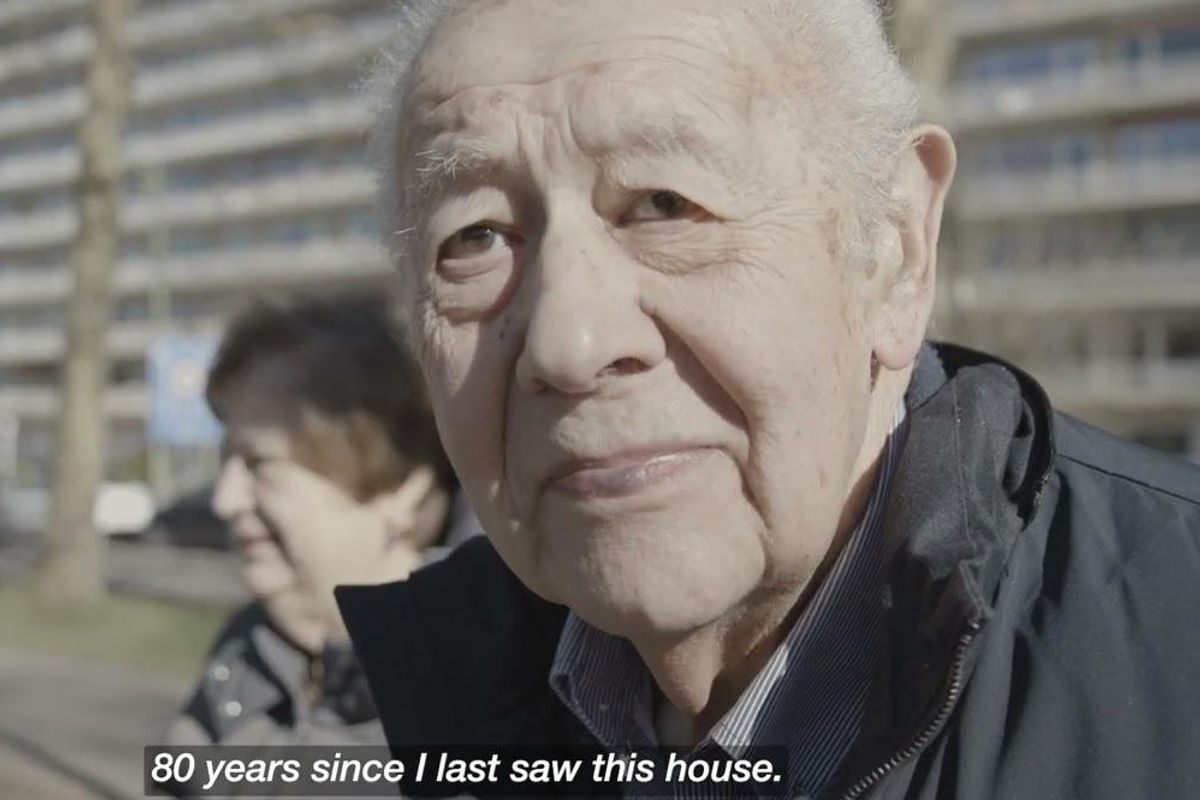Man tracks down the family that saved his life by hiding him during the Holocaust 80 years ago
His dying wish was to thank them.

David Rossler returns to the place where he hid from the Nazis during World War II.
David Rossler, 84, and his mother were taken in by Georges Bourlet and his four young adult children in 1944 and allowed to hide in their home in Brussels in the waning months of World War II. Rossler and his mother were Jewish, and Belgium was occupied by Nazi Germany. If caught, they’d be taken to a concentration camp.
Rossler had already lost his uncle and grandfather after they were taken to Auschwitz concentration camp in Poland and he would lose his father, hiding elsewhere, to an illness.
Bourlet and his family were also in danger if they were caught hiding the mother and child from the Nazis. "People who protected Jews were simply risking their lives. You wouldn't end up in jail, but in Auschwitz—and Auschwitz, you didn't end up anywhere but in the crematoria," Rossler said in a video produced by MyHeritage.com.
After Allied forces liberated Belgium in 1945, Rossler, who was born Daniel Langa and later took the name of his stepfather, moved to Austria and lost touch with the Bourlets.
As Rossler entered his 80s and was in declining health, his final wish was to thank Bourlet’s family for the incredible bravery and humanity he showed him and his mother during the war.
For years, Lionel Rossler, David’s son, did everything he could to find the family, including putting ads in the paper and posting on social media. After one such post, he received a message from Marie Cappart, country manager for MyHeritage in Belgium, who wanted to help.
MyHeritage is an online genealogy platform with 90 million family trees. Rossler's story hit close to home with Cappart.
"My husband lost his grandfather during the war. He died at the concentration camp in Auschwitz-Birkenau," Cappart told Newsweek. "My own great-grandmother also died in the camp at Ravensbrück. She was British and was in Belgium as part of the resistance. Sadly she was caught by the Nazis and deported. She never came back."
\u201cDavid Rossler, center, with members of the Bourlet family. A Belgian genealogist recently helped the 83-year-old man reunite with the family that saved him and his mother during World War II.\n\nhttps://t.co/CVWQ3SLbH0\u201d— Stephen Uzzell (@Stephen Uzzell) 1653404305
“After browsing records and cross-referencing data, Cappart found an Anne-Marie Bourlet, born in Auderghem in 1929,” Lionel said, according to SWNS. “She discovered that Anne-Marie married someone with the surname Dedoncker and had five children—all of them possibly still alive.”
“After a bit more research, Cappart found Xavier, one of Georges Bourlet’s grandsons, and managed to contact him,” he continued.
Finally, after 75 years, David Rossler returned to the place where he hid in 1944 and 1945 and thanked Bourlet’s five grandchildren.
\u201cA man has returned to the home he and his mother hid in from the Nazis nearly 80 years ago - while his uncle and grandad died in Auschwitz. David Rossler, 85, was just five years old when he and his mother, Haja Sura Zoltak, were hidden by the Bourlet\n\nhttps://t.co/jmFZsupNaJ\u201d— Times of Bristol (@Times of Bristol) 1675784891
“It was an incredibly emotional day for us,” Lionel explained. “I was able to see, with my own eyes, the place where my father was kept safe from the Germans all those years ago.”
“If I had Mr. Bourlet in front of me, I would want to kiss him,” said David. “To say thank you with all my body, with all my life, I am alive, I have a family of which I am very, very, very proud. To tell him that my life is thanks to him.”
Bourlet didn’t know it then, but his bravery saved the lives of nine people.
“Because of his heroic action, Georges was able to save the lives of my father and grandmother,” Lionel said. “Nine people were saved thanks to what he did; my brother, myself and our children would not be here today if not for his courage and kindness.”
As a final “thank you” to Bourlet and his family, the Rosslers want him to be recognized as Righteous Among The Nations at Yad Vashem, the World Holocaust Remembrance Center. This honor is for non-Jews who risked everything during the Holocaust to save Jewish people.
The medal given to honorees has an inscription with the Hebrew saying: "Whosoever saves a single life, saves an entire universe.”
- Holocaust survivor uses banknote clue to find the family of 'kind' soldier who liberated her ›
- 101-year-old Holocaust survivor shares the secret to becoming the 'happiest man on Earth' ›
- 98-year-old Auschwitz survivor is using TikTok to share her story with young people ›
- Dietrich Bonhoeffer's theory that stupidity is worse than evil - Upworthy ›

